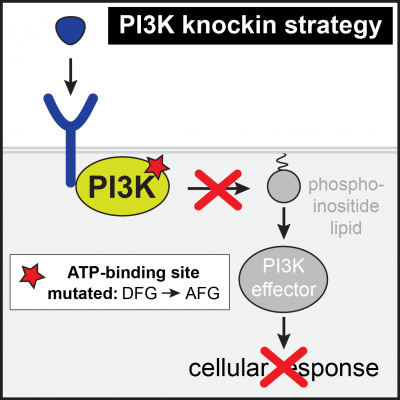We have pioneered the use of a genetic kinase ‘knockin’ strategy in which a single point-mutation in the mouse germline creates an inactive PI3K (reviewed by us in [1]). To the best of our knowledge, the PI3K delta isoform of PI3K was the first kinase subjected to this type of genetic modification in mice [2]. Similar to small molecule inhibitors, this approach does not affect the expression of the PI3K protein and thus more closely models the use of a PI3K drug at the organismal level than gene knock-out strategies.
Using this knockin strategy, we have uncovered physiological roles of the PI3K alpha [3, 4], p110beta [5, 6] and PI3K delta [2, 7] isoforms of PI3K. We have also employed the same strategy to target class II [8] and III PI3Ks and are currently in the process of characterising these mice and cells thereof.

References
- Vanhaesebroeck, B., et al., Signalling by PI3K isoforms: insights from gene-targeted mice. Trends Biochem Sci, 2005. 30(4): p. 194-204.
- Okkenhaug, K., et al., Impaired B and T cell antigen receptor signaling in p110delta PI 3-kinase mutant mice. Science, 2002. 297(5583): p. 1031-4.
- Foukas, L.C., et al., Critical role for the p110alpha phosphoinositide-3-OH kinase in growth and metabolic regulation. Nature, 2006. 441(7091): p. 366-70.
- Graupera, M., et al., Angiogenesis selectively requires the p110alpha isoform of PI3K to control endothelial cell migration. Nature, 2008. 453(7195): p. 662-6.
- Guillermet-Guibert, J., et al., The p110beta isoform of phosphoinositide 3-kinase signals downstream of G protein-coupled receptors and is functionally redundant with p110gamma. Proc Natl Acad Sci U S A, 2008. 105(24): p. 8292-7.
- Kulkarni, S., et al., PI3Kbeta plays a critical role in neutrophil activation by immune complexes. Sci Signal, 2011. 4(168): p. ra23.
- Ali, K., et al., Essential role for the p110delta phosphoinositide 3-kinase in the allergic response. Nature, 2004. 431(7011): p. 1007-11.
- Alliouachene, S., et al., Inactivation of the Class II PI3K-C2β Potentiates Insulin Signaling and Sensitivity. Cell Rep, 2015. 13(9): p. 14.
 Close
Close


